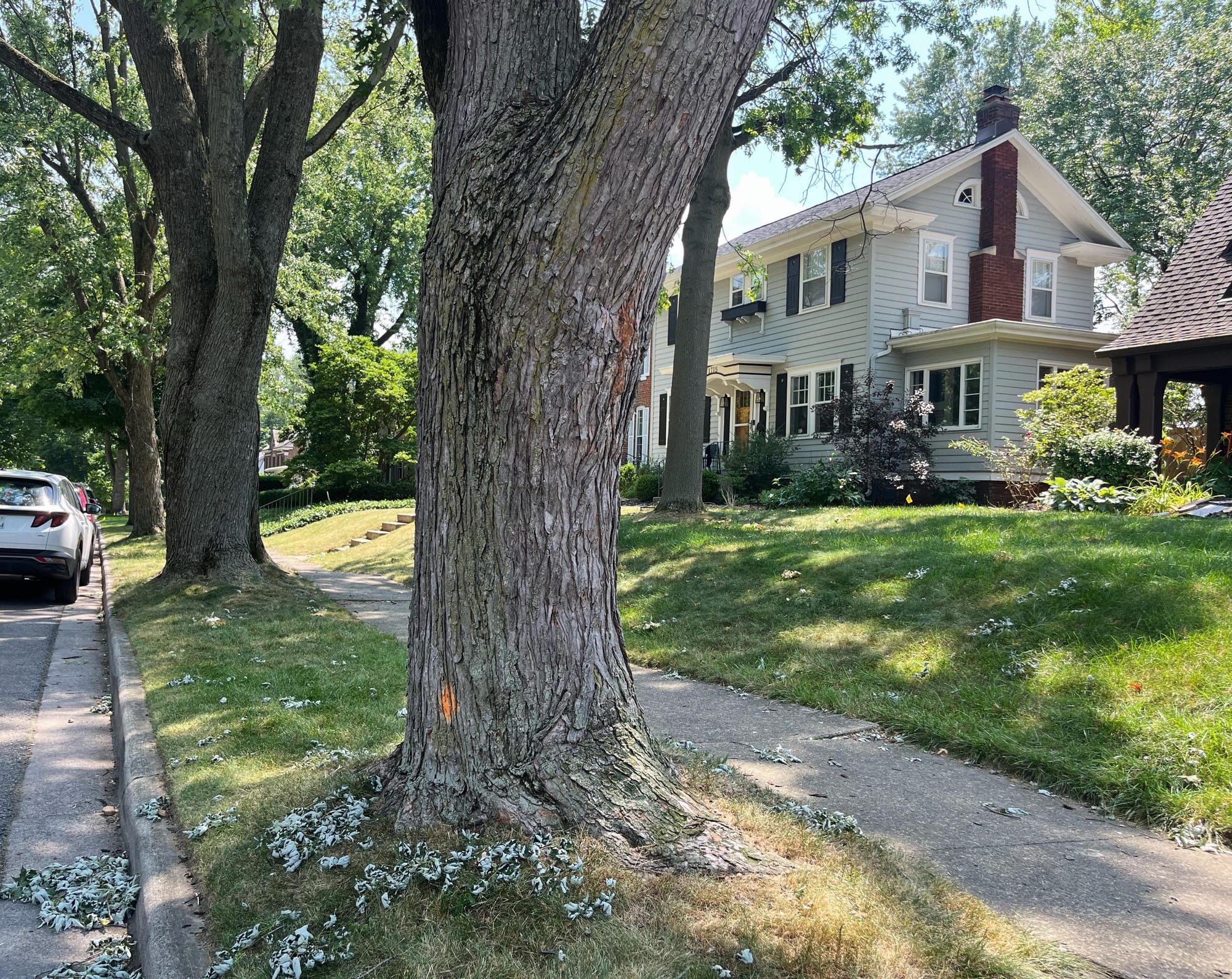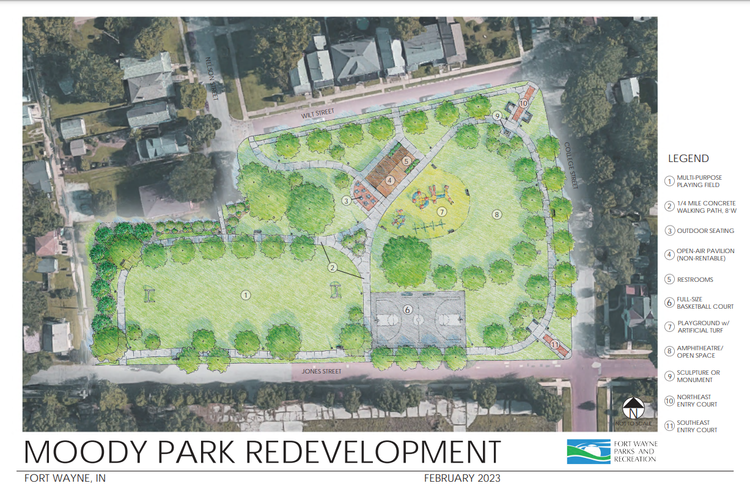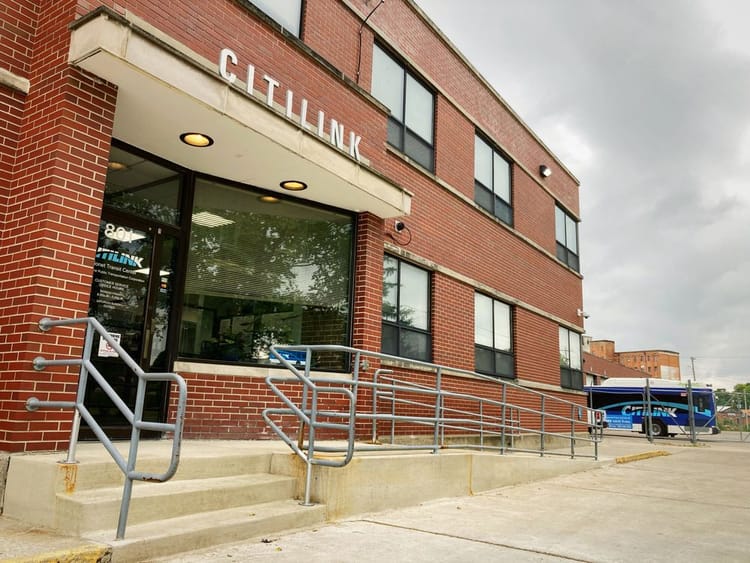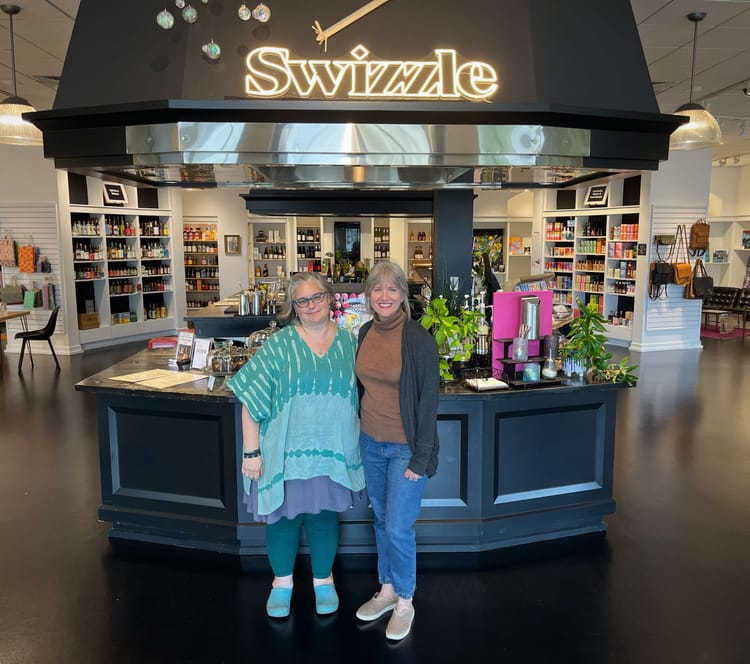Let’s talk about street trees and Fort Wayne’s tree canopy

In the past decade, the land covered by trees in Fort Wayne has declined from 29 percent to 23 percent. And the causes are many: from urban development and city growth to severe weather damage and the infamous Emerald Ash Borer.
In recent years, Fort Wayne’s Parks & Recreation department has been assessing and working to replenish the city’s tree canopy. Superintendent of Forestry, Derek Veit, even created a separate nonprofit entity in partnership with neighborhood leader Kody Tinnel called the Tree Canopy Growth Fund to raise money and plant trees on private properties, like schools.
Parks Deputy Director Alec Johnson says these efforts are critical to Fort Wayne’s tree canopy growth because Parks & Rec. is only responsible for select trees on city land. This includes about 50,000 street trees in the right-of-way along nearly 1,300 miles of roadway and about 20,000 trees within the city’s 89 parks. Trees on private property around homes and schools are generally out of their jurisdiction.
“Within Parks, we can only impact a fraction of the city’s tree coverage,” Johnson says. “But we can make a bigger impact on the city’s tree canopy by having programs or incentives that encourage people to plant trees in other places, like their yards.”
Within the city’s control, Fort Wayne’s total tree planting this year is shaping up to be about 1,000 new trees and about 180 of those per year are planted through the Citizen Match Tree Planting Program, where citizens share the cost ($50) with the city to plant seedlings in the right-of-way near their homes.
The program is now open, and the deadline to apply is July 1. Tree planting contractors will start planning trees Oct. 1 and typically finish by Jan. 1, 2025.
“We have seen increased interest in the Citizen Match Tree Planting Program in recent years,” Veit says. “I call it ‘green energy.’ Fort Wayne is recognizing the power of tress now more than it used to.”
With this in mind, we recently received a question from a reader in the Northside Neighborhood, regarding multiple large street tree removals along Columbia Avenue (near Conjure Coffee). They wanted us to look into what was going on and explain to other residents how they might find out if street trees near their own homes are at risk of removal.
We sat down with Veit and Johnson to find out – and get an update on Fort Wayne’s tree canopy, in general.

First things first: Tell us why residents might see street trees disappearing in the Northside area and how the city’s tree removal process works.
DV: Within Parks, we have a routine of looking for trees that are dead and/or dangerous for removal, and it takes all summer long. Trees are currently prioritized for removal based on a windshield perspective. Basically, our team of Certified Arborists are is driving around, looking at every city-maintained tree, and looking for obvious issues or signs of decay. We evaluate them for likelihood of failure and likelihood that their failure will impact a target –whatever’s underneath the tree. So a tree hanging over a street, playground or public walkway will have higher priority than a tree in an empty field. (If you see issues with trees we might not be aware of, please submit a ticket to the 311 call center, and we’ll do a more thorough inspection.)
When we find a tree that needs to be removed, we mark it with paint, and then a subcontractor comes out to remove it at a later date. In the Northside area, there are a lot of large, over-mature Silver Maples that are simply a liability at this point. Many of these are older trees that hang over the public right-of-way, so that’s what makes them subject to removal, and we only remove them when we believe they present a risk to public safety.
One big reason for Silver Maples is their age. I haven’t met the arborist from Fort Wayne who has admitted to planting Silver Maples yet. But one story I’ve heard is: After World War II, soldiers didn’t have jobs, and one task was planting trees along city streets. So people would drive pickup trucks full of seedlings and put them into the ground wherever they saw a spot. So you now have streets lined with these trees that were planted about 75 years ago, and many of them are becoming over-mature, perhaps faster than another species of tree would. Silver Maples can live up to 130-150 years, but most in urban settings, they live between 35-100 years. Unfortunately, they’re reaching their limits, and in areas where they’re plentiful, they’re coming down all at once.
If a beloved tree needs to be removed, could citizens keep its stump or use the stump for an art project?
DV: If it’s on their property they can. We’ve done it occasionally in parks, but we have to assess the tree stump to make sure it’s structurally safe, and it’s harder to allow homeowners to use stumps for projects when the stump is in the public right-of-way. It’s also a matter of time. In Fort Wayne, there’s 1,300 miles of roadway and about 50,000 street trees. And there are only two of us trying to do all the organizing and scheduling for trees that need work.
How many total trees will need to be removed by Parks department this year, and how can residents find out if a tree near them is at risk?
DV: I anticipate Parks removing about 1,000 trees this winter into spring. A 2014 study concludes that typical street tree annual mortality can expected between 3.5% and 5.1%, and we anticipate staying below this attrition rate.
When it comes to removals each year, we know how many dollars we have to do tree removals, but we don’t always know how many trees that’s going to cover until we start working through the process. So we try to communicate with neighbors through neighborhood associations, which is what we did in the Northside area. When we talk with neighborhoods about tree removal, we also talk about how they might replace lost tree canopy.
We realize that Northside is a neighborhood that identifies with their trees, and we have been working with the Northside Neighborhood on strategies for replacing lost tree canopy through Parks (street trees) and the Tree Canopy Growth Fund (yard trees). They sent out a survey to gauge interest and, from what I understand, received considerable feedback. It sounded like they were also working to secure additional grant dollars to apply toward this initiative.
Should citizens be on the lookout for trees in their yard marked with paint for removal?
DV: Those marks are more for the contractor removing trees, and they can mean different things. But they can indicate to residents that something is going on. If you’re concerned about a tree in your area, you’re always welcome and encouraged to call our Parks main number (260-427-6000). We get a lot of 311 calls when people notice a tree or something else in their yard is marked. Utility companies also might mark trees for removal.
How else might citizens stay informed about tree removals and other parks updates in their area?
AJ: Big picture: We operate within the neighborhood association and area partnership ecosystem as city staff. It helps us reach large groups of the public at once, and if people have concerns, they can reach out at neighborhood meetings or contact their neighborhood association leaders.
When we know we’re taking down trees as part of our tree maintenance program, we try to keep the neighborhoods informed, and then expect neighborhood associations to disseminate that information. We have Deputy Directors of Parks who attend partnership and neighborhood association meetings in all parts of the city and give updates there. That’s the system set up to enable to us to work with the public. We want to keep the public informed on what we’re doing as much as we can.
How can residents use the Citizen Match Tree Planting program to potentially replace lost trees?
DV: We have about 14,000 vacant street tree-planting sites throughout Fort Wayne. For this reason, we aren’t able to plant/replace trees based on request alone. But we encourage residents to apply for replacement trees through the Citizen Match Tree Planting program.
To get a tree, we ask for a $50 contribution from residents, and you can quality to have it waived based on household income and family size. (See the application on the Parks and Recreation website.) One reason we charge for trees is because we see that citizens take better care of them when they have a financial stake in the tree. Some neighborhoods are agreeing to pay for some or all of its residents’ trees, using the Neighborhood Improvement Grants via Community Development. One neighborhood received the maximum grant of $5,000 and used it to plant 100 trees.
Overall, we have seen an increased interest in the Citizen Match Tree Planting Program in recent years. I call it ‘green energy.’ Fort Wayne is recognizing the power of tress now more than it used to. And the Northside Neighborhood is a good example. They recognize that if we can keep our neighborhood green, that’s good for property values. That’s good for the environment and the tree canopy – for all kinds of reasons.
What are challenges with the Citizen Match Tree Planting Program and how are you working to address them?
DV: One challenge with the Citizen Match Tree Planting Program is: we need to make sure trees are offered more equally throughout the city. If you look at our current quadrant system (Northeast, Northwest, Southeast and Southwest), the Southeast district has 14 percent of the city’s total roadway mileage, so they should get roughly 14 percent of its total trees.
One way I’m working to help more neighborhoods get trees is through the Tree Canopy Growth Fund. We started at Southwest Allen County Schools (SACS) with the “Shading Our Children” project to plant 500 new trees on campuses throughout the district, and we started with SACS because that’s where we saw initial interest. But we’re in communication with Fort Wayne Community Schools and trying to build interest in an even bigger tree planting effort there.
In 2021, the Parks department also did a tree canopy cover study, which measured canopy coverage in Fort Wayne, and we broke it down into census blocks. What is obvious when you look at the map is: where you have the least tree canopy is where you have the most impervious surface (roads, sidewalks, parking lots, etc.). So the immediate Downtown area shows up as being the least green. You also see a lot of areas that are not green in the suburbs and around new developments.
With projects Downtown, what are the street tree requirements?
AJ: I review all projects Downtown to ensure they’re meeting the street tree requirements. A good example is the new Pearl Street development. When they submitted that project to the city, it was my job to let them know how many street trees they needed to plant.
In residential areas, every 40 feet along the public right-of-way needs a tree, and in commercial or industrial areas, it’s every 50 feet. Downtown, it can be even closer than that (about every 20 feet) because the trees tend to grow smaller when you’re planting in tree grates or near sidewalk.
Whenever we do a streetscape project or urban trail, street trees are part of those plans, too. Every block of the new Urban Trail underway Downtown will have trees, if conditions allow it. Community Development and Public Works really do appreciate street trees as an important part of projects.
Streets aren’t the only places trees can go Downtown. Could we see more green roofs in Fort Wayne?
AJ: It’s still a pretty tough sell in Fort Wayne. I think what you’re seeing is baby steps. A lot of new buildings Downtown are at least painting roofs white now (instead of black) to deal with the heat island effect. The Ash Skyline rooftop garden we have Downtown is more of a recreation space, not just a green roof. But it’s a start.
Overall, green roofs are a tough sell because it’s an additional cost and in some people’s minds, it’s still a risky move and not what they’re used to. The best thing the city can do, as an entity, is to find ways to incentivize it. That’s going to play into a Climate Action Plan the city is working on. We’re starting to get to the point of talking about specific strategies to deal with climate change in that plan, and that’s where you’ll start to see some of these strategies being rolled out. The Climate Action Plan was a significant goal for Mayor Tom Henry, and we imagine Mayor Sharon Tucker will continue the effort.
Tell us about other developments underway with greenspaces and parks in the city.
AJ: As far as additional green spaces Downtown go, we’re going to continue to see progress in riverfront development Phase 2 this year. For more than a year now, our consultants in Parks have also been working on a Parks Comprehensive Plan with robust public input. It will identify areas across the city where we need to fill gaps in greenspace and park space. It also identifies where we fall short compared to other cities of similar size as Fort Wayne.
The Draft Comprehensive Plan is currently available on Engage Fort Wayne for review and public comment. It will remain available until July 13th. At that time, we will make any necessary changes, and present to the Fort Wayne Board of Park Commissioners for adoption.
Can you share any early findings from the Parks Comprehensive Plan so far?
AJ: What we’re finding, anecdotally, is that the city has been growing, and basically now, it’s predicted to grow at a rate of 1.5-1.9% between 2024-2027. In order for Parks to keep up with that growth, we need resources to build more parks, take care of more parks, and budget for additional staffing. All of these things have to slowly increase for us to keep up with growth in the city’s population. Our Parks Comprehensive Plan will do a good job of describing this need.
We know people love and appreciate Fort Wayne’s parks system and support it. We just want to make sure in all of the talk and excitement about growth Downtown and in neighborhoods, we’re able to keep providing amazing park spaces and maintaining what we have. So the plan will identify gaps, needs and make recommendations on funding for our department and staffing.
Anything else you’d like to say that we didn’t ask?
DV: A question I get a lot is: What is the biggest threat to our tree canopy cover? My answer is: indifference. I’m always thinking about: how do we make people care about trees? Along with all the benefits and value to the environment they provide, they also offer social, mental and physical health benefits. So even when I get phone calls or questions from people who are upset about tree removals, it really does encourage me that people care.
It’s encouraging that people care enough to speak up.





